| French Motet in the Thirteenth
Century10 |
| 音楽エッセイのページへ戻る | 初期多声音楽 | St.マーシャル楽派へ |
| Leoninのページへ | ノートルダム楽派(conductus)のページへ |
ペロタン(Viderunt Omnes) |
| ペロタン(Alleluja Nativitas) | ペロタン Clausulaのページ | まうかめ堂さんのページへ |
| substitute clausulaのページへ | 中世音楽のページへ | 前のページへ |
| 次のページへ |
| Rondeau-motet Introduction and repertory The rondeau-motet is a familiar landmark in the history of thirteenth-century polyphony.1 1t is one of the few subgenres that has been proposed for the motet, and therefore commands our attention. ln this type of motet, one of the upper voices is written as a siχ, or eight-line rondeau. As in the monophonic rondeau, both types use a refrain which appears at the beginning and end, and partially in the middle, of the eight-line rondeau-motet. In the six-line version, there is no occurrence of the refrain at the beginning of the piece. Beyond these general observations, many of the dozen or so rondeau-motets behave rather differently. 0f these works, listed in Table 5.1, a small number will be seen to share similar characteristics. They are also found in the same manuscripts, and may be tentatively classified as a subgenre.2 The remainder have only general features in common。 ロンドーモテットは、13世紀のポリフォニーの歴史における、親しみやすいランドマークである。それは、モテットに対して提案された数少ないサブジャンルの一つであり、それゆえ、我々の注意を惹く。モテットのこのタイプでは、上声部のひとつは6行あるいは8行のロンドーとして書かれている。単声ロンドーにおいては、両タイプは8行ロンドーモテットの最初と最後に、一部には途中で現れるrefrainを利用している。6行ロンドーにおいては、作品の最初に、refrainは現れない。こうした一般的観察とは別に、多くのロンドーモテットはむしろ異なる振る舞いを見せる。 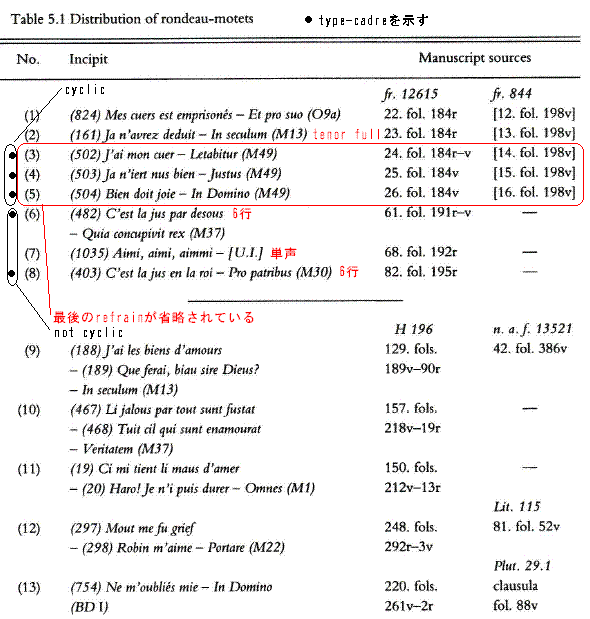 Distinctions between the first eight items and the remaining works in Table 5.1 are fundamental to any enquiry into this subject. A11 the first group survive in the Noailles chansonnier and in the indeχ to Roi. The second group are all found in Montpellier with concordances in manuscripts related to it geographically, chronologically and in terms of repertory and distribution. It is unfiortunate that, in recent discussions of the vernacular motet, this distinction was lost and that all the compositions in Table 5.1 have subsequently been grouped together as rondeau-motets.3 最初の8つと残りの間の区別は、研究すべき基礎である。No.1~8の最初のグループはNoaillesシャンソン集に属しており、Roi写本の索引中にもある。No.9以降のグループは、その地理的歴史的に、あるいはレパートリーと分布の面において関係のあるモンペリエ写本中に認められる。最近の俗語モテットに関する議論では、こうした区別が失われ、Table 5.1中の作品すべてがロンドーモテットとして一緒くたにされていることは、不幸なことである。 Noailles rondeau-motets The idiosyncratic nature of the works in the Noailles manuscript was recognised by Gennrich in 1921 when he observed that not only were the upper voice-parts in the form of a rondeau but that the tenors were similarly constructed. His primary concern was to use this information for the accurate reconstruction of polyphony in which the tenors had suffered severe teχtuai disturbance. Noailles写本中の作品の特有の性質は、Gennrichによって1921年に認められた。彼はロンドー形式の上声部だけでなく、テノールもまた同じように構成されていることを観察した。彼の初期の関心は、テノールがいくつかの歌詞の混乱をしていたポリフォニーの正確な再構成のために、こうした情報を利用することであった。 The scribal confusion which created such inaccuracy was a result of the fact that the tenors, all derived from plainsong, were not only subject to structural modification to conform to the pattern of the upper parts but were also notated in the same musical and textual shorthand as the motetus parts. In notating the eight-line rondeau-motet, the scribe mostly attempted to write out line 1−6 and then to provide an incipit for the terminal refrain. こうした不正確な創作についての書記の混乱は、 すべてプレインソング由来のテノールが上声部に合致するような構造的修正を受けるだけでなく、motetus部分として同じ旋律と歌詞が省略記譜されたという事実の結果であった。8行ロンドーモテットの記譜において、書記は大部分、第1〜6行にこだわり、最後のrefrainの終止点を打ったのである。 Without a text to serve as a guide, he was faced with insurmountable problems when he came to the tenor. The upper parts of the two siχ-line rondeau motets (Table 5.1, nos. 6 and 8) are written out in full, as is the scribe's first attempt at an eight-line rondeau(no. 1). N0. 2 is exceptional and is discussed below. Nos. 3,4 and 5 establish the basic pattern of abbreviating the final refrain. The further abbreviation of lines 3−4 of no. 5 is a direct result of the close association of its teχt with those of the two preceding poems. 書記は、テノールについて多くの問題に直面した。ふたつの6行ロンドーモテット(Table 5.1, nos. 6 and 8)の上声部は、書記の8行モテット(no.1)への最初の試みとして、フルに書かれている。No.2は例外であり、以後議論される。Nos. 3,4 and 5は、最後のrefrainを省略する基本パターンができている。No.5の第3〜4行のさらなる省略は、ふたつの先立つ詩のそれとともにその歌詞の密接な関連の直接的結果である。 The monody, no. 7, is fully notated. The only tenor part written out in full is that for no. 2. The remainder either provide notation for the first two lines (the refrain of the upper voice) or are an attempt to write a longer tenor, the results of which are corrupt. The tenors of the two six-line rondeau-motets presented a similar challenge which the scribe failed to overcome. Understanding this paleographical model is a crucial first step in identifying the musico-poetic structures at work in these pieces. This is not only a question of drawing a distinction between six- and eight-line rondeaux, but also of acknowledging the possibility of the existence of other types of rondet de carole in this repertory。 No.7の単声作品は、フルに記譜されている。唯一、テノールパートがフルで書かれた作品は、No.2である。残りの作品は最初の2行(上声部のrefrain)への記譜を供給し、長いテノールを書く試みをしている。結果はしかし、失敗している。2つの6行モテットのテノールは、書記が克服に失敗した同様の試みを保持している。こうした古文書学的モデルの理解は、音楽と詩の構造を同一化する決定的な最初のステップなのである。これは、6行と8行ロンドーの区別をする問題だけでなく、このレパートリーにおける rondet de caroleの他のタイプの存在の可能性への認知でもある。 The tenor structure of the rondeau-motet is determined by that of the upper parts. This is almost unique in the field of thirteenth-century chant-derived polyphony. In general, the structure of the tenor is usually independent of the structure of the motetus and triplum. In structuring the tenor of the rondeau-motet, as in the case of any motet, the composer was required to supply a contrapuntal voice-part derived from plainsong. Because of the brevity of the pieces, a Gregorian melisma of between eight and twenty pitches was needed. In Table 5.1, nos. 1, 3, 4, 5 and 6 all use a short melisma unique in the motet repertory, whereas nos. 2 and 8 use fragments of much longer ones: In seculum and Pro patribus, well known and widely distributed。 ロンドーモテットのテノールの構造は、上声部の構造によって決定される。これは13世紀のポリフォニー由来のチャントの分野において、唯一のものである。一般的に、テノールの構造は通常はmotetusやtriplumのそれとは独立している。ロンドーモテットのテノールの構築においては、モテットのケースと同様、作曲者はプレインソングから由来する対位法的声部を供給する必要がある。作品の簡便さのために、8ないし12pitch(音符数)のグレゴリオ聖歌のメリスマが必要とされた。 Table 5.1における nos. 1, 3, 4, 5 and 6 はモテットレパートリーにおいて、短い独自のメリスマを使用している。一方で、nos. 2 and 8はより長いものの断片を使っている。In seculumと Pro patribusはよく知られているように、ひろく使われているテーマである。 To judge from Gennrich and Tischler, there would appear to be two types of structure used in the upper voice-parts of these compositions: the six-line and the eight-line rondeau. In the former case Anderson suggested that the ‘original' form of the eight-line rondeau-motet should be reconstructed by expanding six-line structures, placing the refrain not just at the end of the lyric but also at the beginning. This accorded with the observations made by Marcel Fran^on five years earlier.4 Gennrichと Tischlerの研究から判断して、こうした作品の上声部で使われた構造の、6行、8行ロンドーの2つのタイプが明らかになった。前者においては、Andersonが、8行ロンドーモテットのオリジナルな形は、(叙情詩の最後ではなく)最初にrefrainを置いて6行構造を伸長することで再構成されるべきである、と提案している。これは、Marcel Fran^onによって、5年早く観察されている。 Anderson and Fran^on shared the concept of a ‘regular' rondeau structure in the thirteenth century from which an other presentations are deviations. Fran・;on worked to this from his view of the fifteenth-century rondeau,5 and Anderson's point of departure was the tradition of coaxing thirteenth-century song into formes fixes which had begun with Gennrich.6 A better perspective of these rondeau-motets is obtained by viewing them within the context of the thirteenth-century tradition of the rondet de carole.7 This, as is well known, first appeared as a written tradition in Jean Renart's Roman de Guillaume de Dole. It survived largely unchallenged at least up to the works of Adam de la Halle,Guillaume d'Amiens and Jean Acart d'Hesdin.8 The corpus of rondets de carole encompasses a vast range of lyric and musico-poetic types. The six- and eight-line rondeauχ are two of the most common. In the conteχt of this more fluid repertory, a siχ-line rondeau or rondeau-motet requires no alteration. Anderson と Fran^onは、他の研究者が見放した13世紀の規則的なロンドー構成の概念を共有した。Fran・;onは、13世紀のロンドーに対する彼自身の見方からこの研究を開始した。そしてAndersonの出発点は、Gennrichの研究とともに始まった形式の修正に13世紀の歌を受け入れる伝統であった。こうしたロンドーモテットのよい見方は、それをrondet de carole(訳注;roudeauの前身)の13世紀の伝統の内容に沿って見ることによって得られる。これは、よく知られているように、最初、Jean RenartのRoman de Guillaume de Dole中の記譜された伝統として明らかになった。それは手付かずのまま、少なくともAdam de la Halle,Guillaume d'Amiens and Jean Acart d'Hesdinの作品に残っている。rondet de caroleは、叙情詩や音楽−詩形式の幅広い範囲を担っている。6行ー8行ロンドーはもっとも一般的なもののふたつである。このより流動的なレパートリーにおいて、6行ロンドーやロンドーモテットは変化を要求しない。 There is paleographical support for this view from the scribe of Noailles. He differentiated between six- and eight-line rondeaux. The eight-line rondeau-motets on fol. 184r‐v of this manuscript were subjected to greater and greater consistent abbreviation. The two six-line rondeau-motets, however, are characterised by the fact that both upper voices are written out in full and both tenors are corrupt.9 The textual disturbance in the tenors of both begins at the same place: between the end of the first phrase and the beginning of the second. The structure of the siχ-line rondeau-motet requires the first phrase to be repeated twice before proceeding to the second musical element. The scribe failed to fulfil this task. In the case of no. 6,he created an ABAB' structure which is obviously an attempt to imitate the beginning of the tenor pattern of an eight-line rondeau but, for no. 8, he simply notated the A and B sections and then organised the now-redundant remainder of the melisma in a similar fashion.10 Noailles写本の書記からのこうした観点に対する古文書学的サポートがある。彼は、6行と8行のロンドーを区別していた。この写本のfol. 184r‐vの8行ロンドーモテットは、絶えず、省略の危機に晒されていた。ふたつの6行ロンドーモテットはしかしながら、両者の上声部がフルに書かれ、そして両者のテノールが崩壊したという事実によって特徴づけられる。両者のテノールにおける歌詞の混乱は、同じ場所で始まる。最初のフレーズの最後と次のフレーズの最初の間である。6行ロンドーモテットの構造は、次の音楽要素へ進む前に、2度繰り返される最初のフレーズを要求する。書記はこのタスクの達成に失敗した。no. 6の場合、彼は8行ロンドーのテノールパターンの最初を真似ようおしてABAB'構造を創造した。しかし、no.8は、彼は単純にAとBのセクションを記譜し、それから今や冗長であるメリスマの残り部分を同様のやり方で編成した。 In a footnote to his remarks concerning the ‘reconstruction' of eight-line rondeau-motets, Anderson suggested that no. 2 in Table 5.1 should ‘not be “restored to full form” without further manuscript evidence'.11 Ever since Gennrich first published this piece, it has been assumed that it is an abbreviated copy of an eight-line rondeau-motet and has usually been reconstructed with two untexted editorial insertions before the final refrain. 8行ロンドーモテットの再構成に関する言説の脚注において、Andersonは、no. 2 in Table 5.1は「さらなる写本の証拠なしにfull formでの再構成をすべきではない」と提案した。Gennrichが最初にこの作品を出版して以来、この作品は8行ロンドーモテットの省略されたものであり、後の方のrefrainの前のふたつの歌詞のつかない編集での挿入での再編成であると考えられていた。 Anderson's caution went unheeded.12 But this is one of only two pieces in Table 5.1 (the other is the monody) which are notated without abbreviation. As it stands in the manuscript, its structure is ABaAB and the piece in this form makes no less musical and textual sense than does its ‘reconstructed' eight-line version. Anderson'の注意は無視された。しかし、このno.2はTable 5.1における、(テノールの)省略なしに記譜されたただふたつの作品の一つである。写本にある通り、その構造はABaABであり、そしてこの形式の作品は、その再構成された8行版より、音楽的にも詩的にも遜色のないものである。 There are no surviving thirteenth-century rondets de carole, monophonic or polyphonic, which exactly mirror this scheme.There are however two rondets de carole in Henri d'Andeli's Le Lai d'Aristote with the structure AabAB. They are similar to the notated version of no. 2 but slightly more regular.13 The differences found in the five manuscript versions of the Lai d'Aristote are all variations on the same type of rondet de carole: a text enclosed by a refrain line at the beginning and a full statement of the refrain at the end. Furthermore, there exists at least one example of a rondet de carole14 which, as in this rondeau-motet, uses a complete refrain at the beginning and end, although with four narrative lines separating them. Anderson was partially correct in this instance that the notated form of (161) Ja navrez deduit-In seculum (Ml3) might not need any ‘reconstruction'. 13世紀のrondets de caroleは残っていないが、モノフォニーであれポリフォニーであれ、このスキームの正確なmirrorである。しかしながら、AabABの構造を持つ2つの two rondets de caroleが存在する。これらはno. 2の版と同様であるが、若干規則的である。 Lai d'Aristote(アリストテレスのレ)の5つの写本に見られる違いは、rondet de caroleの同じタイプのあらゆる違いである。歌詞は最初のrefrain行によって閉鎖され、refrainの全歌詞は最後にある。さらに少なくとも、このロンドーモテットのように最初と最後で完全なrefrainを使っているrondet de caroleの一つの例が存在する。4つの物語行はそれらから離れているが。Andersonは、特にこの例において、(161) Ja navrez deduit-In seculum (Ml3)の記譜された形式が再構成を必要としなかったということで、それは部分的には正しかった。 Rondeau-motet cycle The three pieces which follow Ja n'avrez deduit in Noailles (nos. 3―5 1n Table 5.1) share similar specific characteristics. Choice of tenor melisma, musico-poetic structure,text, compositional procedure, and distribution are all analogous. These three rondeau-motets constitute a cycle. The tenor melismas on which these motets are based are all taken from the same liturgical item: the verse of Alleluya. Letabitur iustus in Domino for the Common of Martyrs.15 The relevant part of the alleluya verse is given as Example 5.1. Noailles写本中のJa n'avrez deduitの後の3作品は、同じような性格を共有している。テノールの選択、音楽と詩の構造、歌詞、作曲手順、再分配等が類似している。これら3つのロンドーモテットはcycle構造を作っている。こうしたモテットがベースとしたテノールのメリスマは、同じ宗教アイテム、 Alleluya. Letabitur iustus in Domino のverseから取られている。alleluya verseに相当する部分は、Example 5.1.で示されている。 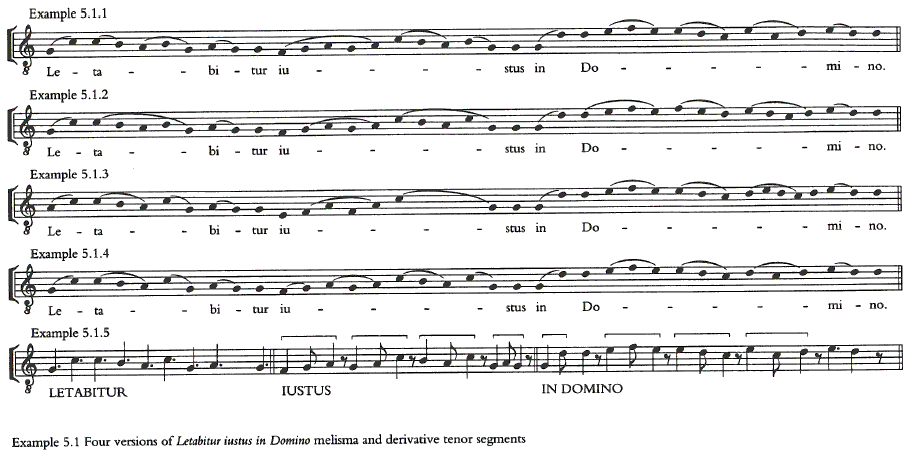 Since it is impossible as yet to identify the precise source from which the plainsong was derived, it is given in several versions - from (5.1.1) the modern Vatican gradual,16(5.1.2)a twelfth-century gradual from the Auvergne,17 (5.1.3) a thirteenth-century Parisian missal18 and (5.1.4) a thirteenth-century Parisian missal and gradual combined.19 The tenors of the motets are given as Example 5.1.5. The three tenor melismas are not only taken from the same liturgical composition, they also follow each other in order and without a break. Taken together, then, the motets can be viewed as a cyclic polyphonic setting of the first three melismas of the alleluya verse. Figure 5.1 shows the correlation between the plainsong (given in the version shown as Example 5・1.3) and the texts of the three rondeau-motets.20 プレインソングの由来する正確な資料を同定することが困難なため、上例では、(5.1.1)からのいくつかの版が示されている。3つのテノールのメリスマは同じ典礼作品から取られているだけでなく、互いに途切れることなく、順番に従ってもいる。モテットは、alleluya verseの最初の3つのメリスマの循環ポリフォニー設定となって見られる。Figure 5.1は、プレインソング(given in the version shown as Example 5・1.3)と3つのロンドーモテットの歌詞との間の関係を示している。 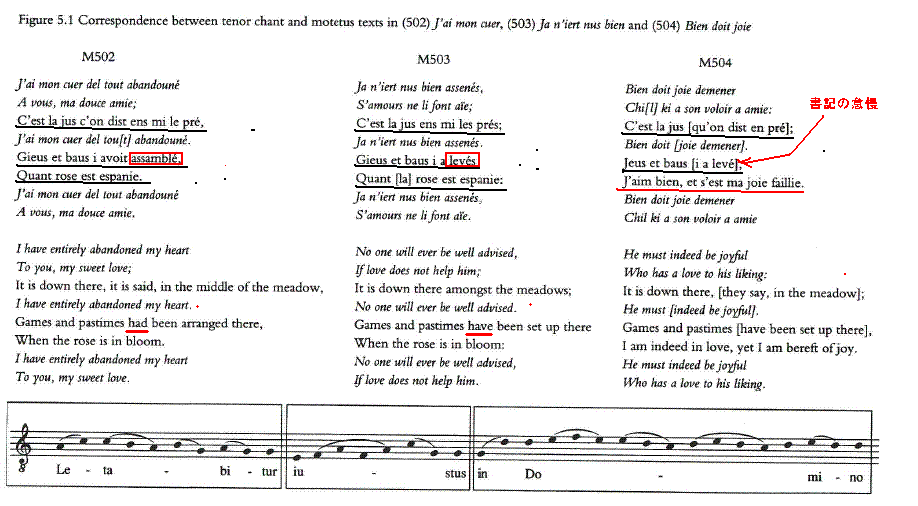 Each of the three plainsong melismas has to be of approximately the same length if all the corresponding upper parts are to be eight-line rondeaux, and this is exactly the result achieved by the composer. As can be seen from Example 5.1, the three tenor melismas consist of nine, twelve and fourteen pitches which are organised into ordines of nine, eight and ten perfections. All the relevant sections of the plainsong are used. The poems used for upper voices are similar not only in structure but also in much of their content.21 3つのプレインソングのメリスマのそれぞれは、できるだけ同じ長さでなければならない。もしもそれぞれ相当する上声部が8行ロンドーであれば、そしてこれが正確に作曲者によって成し遂げられた結果であるならば。 Example 5.1から明らかなように、3つのテノールのメリスマは9,12,14pitchesでできており、9、8、10perfectionのordinesを持っている。すべてのプレインソングの相当する部分が使われている。上声部に対して使われた詩は、構造だけでなく、内容にもまた同様になっている。 While the refrain in each poem is different, the remaining lines − what Johannes de Grocheio would have described as the ‘additamenta'22 −are strikingly similar in all three poems. Apart from line 6 of the third poem, the very slight changes in thenon一refrain lines are a result of the structure of the refrain, which determines the musico-poetic structure of the rest of the poem. The refrain in the first poem consists of nine- and six-syllable lines, in the second of seven‐syllable lines and in the third of seven- and nine-syllable lines. This is the reason for the difference between assamble and a pluperfect in the first poem and leves and a perfect in the second. The erratic sequence of tenses here is quite typical of much French lyric poetry of the period. By the time the scribe reached the third poem, he gave up writing the same line for a second time and simply gave incipits as indicated by the editorial expansions in square brackets.23 Since the music for each of the refrains is different, identical or near-identical, non-refrain lines in the three poems receive different musical treatments. それぞれの詩のrefrainが異なっており、 Johannes de Grocheioが‘additamenta'として記述した残りの行は、すべての3つの詩において注目すべき類似性がある。第3詩の第6行を別として、refrainではない行の非常にわずかしかない差異は、refrainの構造の結果としてこうなっている。最初の詩のrefrainは、9、6音節行から成り、2番目は7音節行、3番目は7、9音節行から成っている。これが最初の詩のassambleと過去完了形、次の詩のlevesと完了形の間の違いである。時制の誤った連続はこの時代の多くのフランス語叙情詩の典型である。書記が3番目の詩に到達するまでに、彼は同じ行を書くことを諦め、(ここでは)カギ角括弧で示したように、単純にincipitだけを記した。refrainのそれぞれの音楽は異なっているため、3つの詩のrefrainではない行は異なった音楽的扱いを受けている。 There is a curious contradiction here between the mobility of the lyric refrain among the three poems and the stasis of the narrative additamenta. The fact that the narrative elements are similar suggests a community of thought and intention between the three poems. This is irrespective of、 but congruent with, the relationship between the tenors of the three motets. 3つの詩の間の叙情的refrain(訳注;バロック以降のアリアに当たる)の動きと語り的additamenta(バロック以降のレシタティーボにあたる)の間には、興味深い矛盾がある。語り的要素が似ているという事実は、3つの詩の間の思想と意思の共同性を示唆している。これはテノールと3つのモテットとの関係に拘わらず、一致している。 Type-cadre The three teχts that constitute this cycle of rondeau-motets are not simply closely related to each other. They are three poems representative of what Paul Zumthor has termed a type-cadre24 which,in total, comprises the twenty-four texts listed in Table 5.2・ ロンドーモテットのcicleを構成する3つのテキストは、単純に互いに関係しているわけではない。これら3つの詩は、Paul Zumthorがtype-cadre(frame type)と名づけたものの代表であるといえる。合計で24のテキストを含むtype-cadreが下表に示されている。 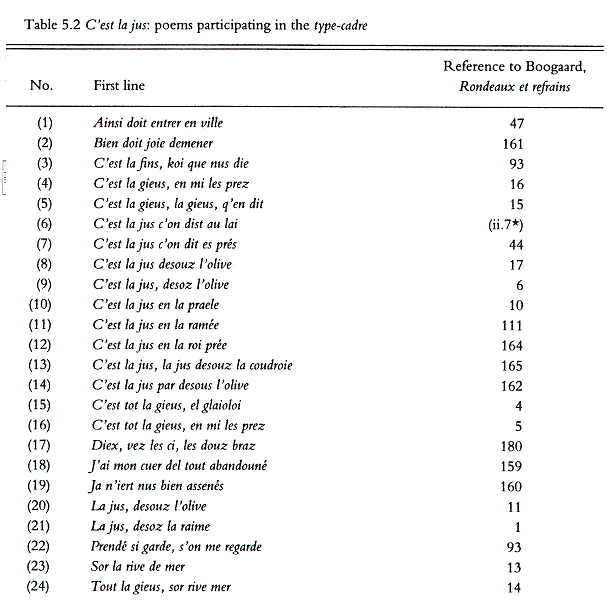 Furthermore, two other motets in Table 5.1 ― nos. 6 and 8 − participate in this type-cadre even though they play no part in the cyclic organisation of items 3−5。 Of the first eight compositions in Table 5.1, then, five share the characteristics of this type-cadre. さらに、 前記Table 5.1中の2つのモテットnos. 6 and 8(6行ロンドー) がこのtype-cadreに加わる。これらは循環構成は取らないが。Table 5.1の最初の8つの作品のうち5つはこの type-cadreの特徴を共有している。 A type-cadre is derived from the segmentation of a repertory of poems according to their shared vocabulary, content and rhetorical technique. For Zumthor, the predominant type-cadre is that of the rencontre, familiar from pastourelle poetry.25 Two lesser type-cadres are those of Belle Aeliz and C'est la jus.26 The appearances of these last two configurations are restricted almost exclusively to the rondet de carole. The type-cadres C'est la jus generates two subspecies which could be labelled respectively ‘well-spring'(as a transation of fontaine) and ‘pastime'. Table 5.3 illustrates the basic formula of the type-cadres, with its two subspecies.27 27 Superscript numbers indicate the number of times that each of the formulations occurs. type-cadreは、共有した語彙、内容、修辞に従った詩のレパートリーの分画から由来している。Zumthorにとって、多数派のtype-cadreは、 rencontreのそれや、 pastourelle詩に近いものである。2つの少数派のtype-cadres は、Belle Aeliz と C'est la jusである。最後のふたつの構成部分は、rondet de caroleにほぼ全面的に制限されている。type-cadres C'est la jus は、2つのサブグループを生成している。それぞれ、‘well-spring'(fontaine) と ‘pastime'でラベル化されている。Table 5.3は type-cadresの基本的な形を示す。 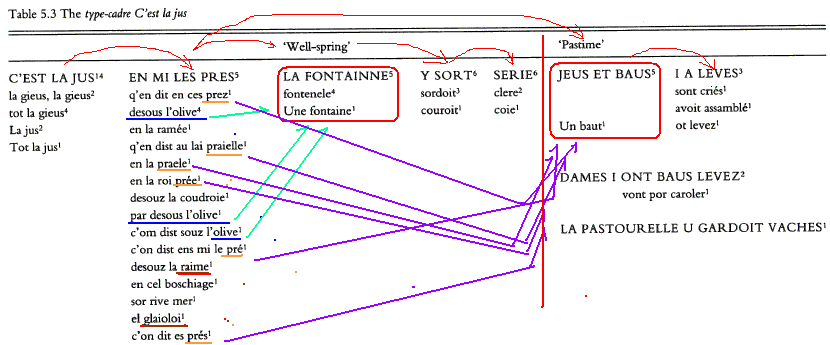 At the simplest level, the first line of the two (which is common to nearly all the examples of the type-cadre), consists of an indicative element (‘It is down there ‥.') followed by an adverbial clause of place which gives rise to a large number of variations. Many of these are simply the result of the metrical exigencies of the poem in which they are found. For example, the first line of C'est la jus par‘desous l'olive (Table 5.2, no. 14) differs from the third line of Ainsi doit entrer en ville (Table 5.2, no. 1 ;the line in question reads: ‘C'est la jus, desous 1'olive') only by the addition of a single preposition. This is caused by the differences in line-length between octosyllables and lines of seven syllables, both with feminine end-rhymes. 最初の行は、多くのヴァリエーションの場を与える副詞句でフォローされた表示要素を伴っている(ここでは小字で下の方に書かれている)。これらの小差の多くは単純に、詩の修辞性の結果である。たとえば、C'est la jus par‘desous l'olive (Table 5.2, no. 14)の第1行は、ひとつの前置詞を付け加えられるだけで、Ainsi doit entrer en villeの第3行 (Table 5.2, no. 1 問題の行は‘C'est la jus, desous l'olive'となっている)とは異なっている。これが、8音節と7音節の行の間の行長における違いの原因となっている。双方ともに女性型終止韻である(訳注;The Selection of Clausula Sources for ThirteenthCentury Motets参照。 There is a tripartite distinction between pre (meadow), olive (olive-tree) and miscellaneous scenarios within the second element of this type‘cadre. About half the poems use a formulation involving pre, while the other two groups are each used in a quarter of the texts. Of the two dozen poems in this type-cadre listed in Table 5.2, ten each fall into the two subspecies of 'well-spring' and ‘pastime'. Four texts make a limited use only of the range of linguistic possibilities represented by these groupings. このtype‘cadreの第2構成部分においては、3つの区別がある。すなわち、pre (meadow), olive (olive-tree) 、その他のごっちゃな部分の3つである。詩のほぼ半分について、pre(meadow)を含む言い回しがある。他の2つのグループはそれぞれテキストの1/4づつを占めている。このTable 5.2中でリストアップされた24のtype-cadreのうち、10が 'well-spring'と ‘pastime'のふたつのサブグループに該当する。 In general, texts which use the formulation ‘olive' are followed by the subspecies ‘well-spring', and those which employ the expression ‘pre’ are followed by the ‘pastime' subspecies. There are, however, sufficient examples of interference between these two pairs of elements not to regard ‘olive’ and ‘pre’as parts of the same subspecies. The following upper-voice text from the motet listed in Table 5.1 as no. 8 is an example of such interference: 一般的に、‘olive' の言い回しを使っている歌詞は‘well-spring'によってフォローされている。そして、‘pre’の表現を取る歌詞は‘pastime' にフォローされている。しかしながら、同じ種類の一部としての‘olive’ と ‘pre’に関するこれらの要素の組み合わせには多くの例外がある。次に提示するmotet listed in Table 5.1 as no. 8 からの上声部は、そうした例外の一つである。 C’est la jus en la roi pree, Cele m 'a s'amour dounee. La fontenele i sort clere. Faus vilains traies en la! Cele m 'a s'amour dounee. Ki mon cuer et mon cors a. It is over there in the steeply-sloping meadow, She has given me her love. The little well-spring runs clear there. False knaves, go away! She has given me her love。 Who possesses my heart and soul. Other examples are not so clear.C’est la jus desouz la coudroie (Table 5.2, no. 13) might very well be considered among that group of ‘pre' texts. Its subsequent use of the ‘well-spring' formulation would therefore represent a further interference. The two texts which use formulations involving glaioloi and raime pose a serious problem.28 It might be argued that Prendes i garde only just qualifies for consideration here since the line which is supposed to take on the ‘pastime' formulation is only very loosely related: ‘La pastourelle u gardoit vaches'.29 In short, then, there are two pairs of variables within the C’est la jus type-cadre:'pre'−‘olive and ‘well-spring' −‘pastime'. The two non-cyclic rondeau-motets which fall into this type-cadre occupy a rather different position to the three cyclic pieces. Comparison of these two groups of poems shows how the bonds between the texts of the three cyclic pieces are stronger than those between the five texts as a whole. There is a further distinction in terms of structure. 他の例はこのようにはっきりはしていない。C’est la jus desouz la coudroie (Table 5.2, no. 13)は、‘pre' テキストのグループに属すると考えられてきた。それに続く‘well-spring' の言い回しの利用はそれゆえ、さらなる干渉を引き起こすであろう。glaioloi と raimeを含んでいる言い回しを使う2つのテキストは、重大な問題を提起する。Prendes i gardeはここで考慮するべき資格がある。なぜなら、‘pastime'の言い回しを持つと仮定される行‘La pastourelle u gardoit vaches'が非常に緩く関係しているからである。要するに、C’est la jus type-cadre内には、'pre'−‘olive と ‘well-spring' −‘pastime'というふたつの変化する組み合わせが存在している。 type-cadreに属する2つの循環形式でないロンドーモテット(訳注;前記Table 5.1中の2つのモテットnos. 6 and 8、ともに6行ロンドー) は,3つの循環形式な作品とは異なったポジションにいる。これら2つの詩のグループの比較は、3つの循環詩のテキストの間の結合が全体としての5つよりもいかに強力かということを示している。構造の面ではさらに違いがある。 Prendes i garde Guillaume d’Amiens-XIIIeme siecle Prendes i garde s'on mi regarde! S'on mi regarde, dittes le moi. C'est tout la jus en cel boschaige, Prendes i garde s'on mi regarde! La pastourele i garde vaches: 'Plaisans brunete a vous m'o troi!' Prendes i garde s'on mi regarde! S'on mi regarde, dittes le moi. The cyclic poems are eight-line rondeaux; the other two pieces are six-line rondeaux. The former all fall into the ‘pastimes’ subdivision; the latter are both examples of the ‘well-spring' motif. The three cyclic poems consistently pair off ‘pastime’ with ‘pre’:this consistency is absent from the other two texts, where, in one case, ‘olive' is followed by ‘well-spring' (the normal sequence) and, in the other case, ‘pre' is followed by ‘pastime'. This latter text has already been given as an example of this type of interference between successive lexical choices.30 In other words, the three cyclic compositions behave in a tightly controlled fashion, and share a maximum number of characteristics. The other two pieces function within the type-cadre in exactly the same variable way that might distinguish any two of the remaining nineteen poems in the group。 3つの循環詩は8行ロンドーである。他の2つ(訳注;前記Table 5.1中の2つのモテットnos. 6 and 8)は6行ロンドーである。前者はすべて‘pastimes’の亜分類に入る。後者は2作品ともに‘well-spring'モチーフの例である。3つの循環詩は絶えず‘pastime’ と ‘pre’とペアになっている。こうした一貫性は他の2つのテキストには欠けている。ひとつのケースでは、‘olive' は ‘well-spring'にフォローされている(通常の流れ)が、もう一方のケースでは、‘pre' が ‘pastime'にフォローされている。後者のテキストはすでにこのタイプの干渉例として示された。言い換えれば、3つの循環曲はきちんとコントロールされた流れとして振舞い、特性の最大数を共有する。他の2作品は,正確にtype-cadre内で、グループ内の残りの19の詩のうちの2つを区別するのと同じ変化の仕方で機能する。 It is an established fact that, within the Bele Aeliz type-cadre, rondets de carole are put together in cycles to create a multi-strophic chanson a carole. Both Delbouille and Bec suggest that the C’est la jus type-cadre also participates in this function but fail to offer any evidence beyond the circumstantial.31 Indeed, there is no evidence that C’est la jus was ever put together in this way. However, the similarity of treatment between the two type-cadres is significant, and it comes as no surprise, therefore, that it is these types of texts that are used in the cycle of rondeau-motets (Table 5.1, nos. 3-5) Bele Aeliz type-cadre内では、 rondets de caroleが多数音節のchanson a caroleを創造するために循環するように配置されたということがすでに確立された事実となっている。Delbouille and Bec は、C’est la jus type-cadreもまた、こうした機能に加わると主張している。しかし、確定した証拠はない。C’est la jus がこうしたやり方に置かれたという証明はない。しかしながら、2種類のtype-cadresの間の同様な取り扱いは重要である。それゆえ、これらのテキストのタイプがTable 5.1, nos. 3-5のロンドーモテットで使われたということは、驚くべきことではない。 Refrains The refrains of monophonic rondeaux and rondets de carole often appear in other contexts as parts of motets, chansons a refrain, chansons avec des refrains and verse narratives.32 Either text only, or both text and notation, can function in this way. Of the eight rondeau-motets in the first part of Table 5.1, only one − the six-line motet (403) C'est la jus en la roi ― Pro patribus (M30) ― has a refrain which is used elsewhere. This raises the possibility of isolating some trends in compositional practice among this group of works. Moreover, the refrain used in this motet, ‘Cele m'a s'amour donee/ Qui mon cuer et mon car a' 、33 is unusual in suggesting a good deal about the balance between borrowed and original material in the composition。 monophonic rondeaux と rondets de caroleのrefrainは、motets, chansons a refrain, chansons avec des refrains , verse narrativesの一部分として他の内容にもたびたび現れる。テキストだけでなく、テキストと記譜双方はこのやり方で機能している。Table 5.1の最初の部分の8つのロンドーモテットのうちのひとつ(6行モテット(403) C'est la jus en la roi ― Pro patribus (M30))のみが、他のところで使われているrefrainを持っている。これはこの作品グループ間の作曲の実践における隔離傾向の可能性を引き上げる。さらに、このモテットで使われたrefrain‘Cele m'a s'amour donee/ Qui mon cuer et mon car a' は、借用した素材と作品内のオリジナルな素材のバランスについての取り扱いについて示唆している点で、珍しい。 Example 5.2 gives the music for all known occurrences of the refrain. Example 5.2.1 is a paradigmatic analysis of the six lines of the motet (403) C'est la jus, all of which are set to variants of the music of the refrain. Only three, lines 2, 5 and 6,employ its text. All except one of the remaining untexted phrases are settings of the text shown at the head of the example. The exception is the appearance of the refrain in Florence (Eχample 5.2.7), where it occurs as part of a clausula melisma. Example 5.2はよく知られたrefrain 'Cele m'a s'amour donneeと'Qui mon cuer et mon cors a'の音楽を示している。Example 5.2.1は、モテット(403) C'est la jusの6行の分析を示している。すべてがrefrainの音楽のヴァリアントである。第2、5、6行の3行はrefrainの歌詞を伴っている。現存している(refrainの)歌詞のないフレーズの一つを除いたすべてはexampleの最初に示されている。その例外はF写本中のrefrainの出現である。そこではクラウズラのメリスマの部分がある。 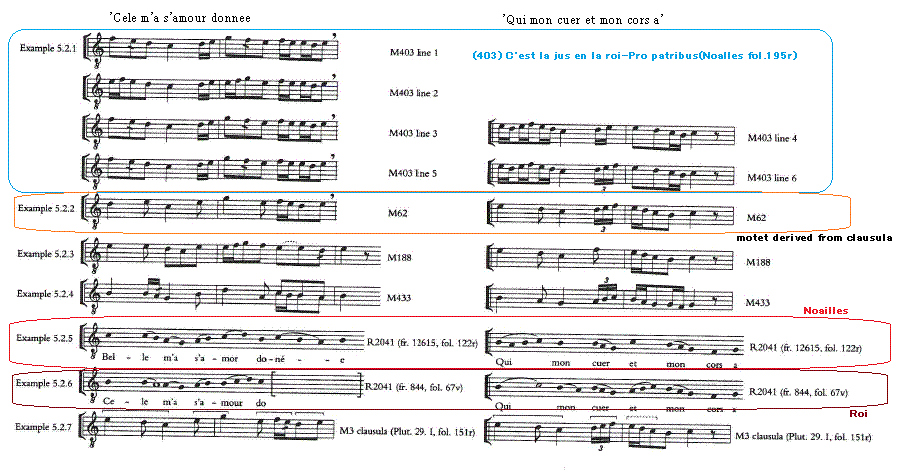 Example 5.2 Versions of refrain 314 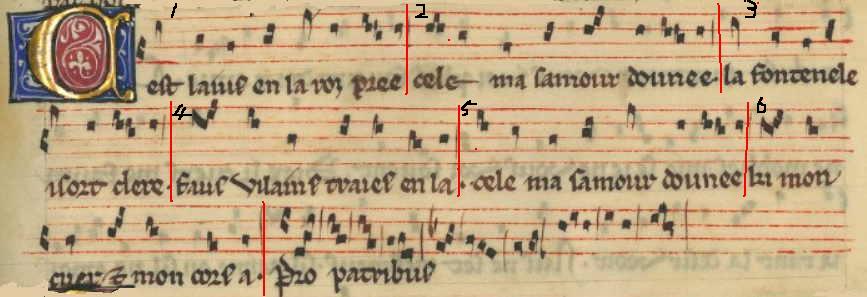 (403) C'est la jus en la roi-Pro patribus(Noalles fol.195r) ln the case of the refrain ‘ Cele m'a s'amour donee / Qui mon cuer et mon cors a', the music to all appearances of the refrain is essentially identical. The clausula from Florence serves as a model for the two-part French motet (62) En mai que neist ―Domine (M3). Near-identical text and music then found their way into three other French motets, one of which was the rondeau-motet (403) C'est la jus en la roi ― Pro patribus (M30). Concerning this group of pieces which share the same musico-textual fragment, Ludwig was in no doubt that they all sprang originally from the clausula.34 refrain ‘ Cele m'a s'amour donee / Qui mon cuer et mon cors a'の場合、refrainの出現するあらゆる音楽は本質的に同一である。F写本中のクラウズラは、2声のフランス語モテット (62) En mai que neist ―Domine (M3)に対するモデルとなっている。ほぼ同一のテキストと音楽は、3つの他のフランス語モテットに入り込んだ。そのうちの一つが、C'est la jus en la roi ― Pro patribus (M30)である。同じ音楽−テキスト断片を共有する作品のグループに関して、Ludwig は、これらはクラウズラを起源としているものとして、疑わなかった。 The text-critical differences between the various appearances of the ‘refiain' are problematic. For example, there are significant differences in pitch, at the beginning of the passage, between the clausula and the motet ostensibly modelled on it. At the same place in the phrase, the rondeau-motet (lines l−4 of Example 5.2) and the Noailles reading of the chanson (line 8) agree on a version which is different both from the clausula (line 10) and the motet derived from it (line 5). This particular agreement is understandable. The differences between clausula and derived motet cannot be explained so convincingly on contrapuntal grounds as pitch differences in motets based on different tenors。 refrainがさまざまに出現する間のテキストの重大な違いにはいろいろ問題がある。たとえば、クラウズラと(表向きはそれをモデルとした)モテットの間のパッセージの最初の音高に関して、大きな違いがある。フレーズの同じ場所では、Example 5.2のロンドーモテットの第1〜4行とNoailles写本のシャンソンについての読譜は、クラウズラとそれ由来のモテットとは異なる版であることで一致している。 この特殊な一致は理解し得る。クラウズラとそれから由来したモテットの間の相違は、異なったテノールに基づいたモテットの音高の違いとして対位法の観点からは、確信して説明されきれない。 In the context of the many variations in the different presentations of the same ‘refrain', both in melodic structure and decoration, the internal inconsistencies in the upper voice of (403) C'est la jus en la roi ― Pro patribus (M30) (visible in lines l−4 of Example 5.2) recede into insignificance. Almost all the differences in the rondeau motet are found, on at least one occasion, in the other examples given in Example 5.2. Whether this implies that the composer of (403) C'est la jus en la roi ― Pro patribus (M30) was aware of the other versions, or whether the rondeau-motet was known to the composer, is a question whose answer depends on many unsupported assumptions concerning compositional method in the period. There are, however, two facts that are relatively certain. 旋律構造や装飾の両方で、同じrefrainのさまざまな表現における多くの変異についての意味では、(403) C'est la jus en la roi ― Pro patribus (M30)の上声部の内部の不一致は、それほど意味を持つまでもなく、後退している。Example 5.2.の他の例では、少なくともひとつの場所において、ロンド―モテットのほとんどの違いが認められる。これが(403) C'est la jus en la roi ― Pro patribus (M30)の作曲者が、他の版の存在に気づいていたかどうかを意味するのか、あるいはロンドーモテットが作曲者に知られていたかどうかは、その答えが、その時代の作曲方法に関する多くの支持されていない仮定に依存した疑問である。そこにはしかしながら、はっきりしている2つの事実がある。 The music of the refrain used in the rondeau-motet (403) C'est la jus en la roi ― Pro patribus (M30) originated in a Notre-Dame clausula, and the text of the same refrain was first composed to this music in the motet (62) En mai que neist la rosee - Ne (M3). The structure of both voice-parts in the rondeau motets listed in the top part of Table 5.1 is borrowed. In all cases except C'est la jus en la roi ― Pro patribus (M30), it is impossible to say how much of the music of the upper parts is newly composed and how much is appropriated from other sources. The foregoing evidence allows the reconstruction of the composer's working methods in this piece alone. Previous general remarks are still valid except for those relating to the question of the choice of tenor melisma. ロンドーモテット(403) C'est la jus en la roi ― Pro patribus (M30)で使用されたrefrainの音楽は、ノートルダムクラウズラに起源がある。そして同じrefrainのテキストは、最初にモテット(62) En mai que neist la rosee - Ne (M3)の音楽に対して作られた。Table 5.1の冒頭に挙げられたロンドーモテットにおける両声部の構造は、借用されたものである。C'est la jus en la roi ― Pro patribus (M30)を除くすべてのケースでは、上声部の音楽のどのくらいが新しく作曲され、どのくらいが他の資料から充当されたのかははっきりしない。上記の証拠は、この作品のみで作曲者の作業方法の再構成を可能にする。以前の一般的発現は、テノールメリスマの選択の問題を除いて、有効である。 In this case, the pitches of the upper part are already determined. Simply choosing a melisma or melisma‐segment of the right length would not have been sufficient here since the selection of the melody to serve as the tenor had to agree contrapuntally with the pre-existing upper voice. The composition of this particular piece is therefore rather the process of fitting two types of borrowed material together. It is the non-refrain lines of text which alre actually newly composed, and this, coupled with the skill of matching disparate types of borrowed material, represents one of the principal points of interest in the work. It is certainly fortunate that the only rondeau-motet whose refrain survives in more than one source yields so much information on this subject. このケースC'est la jus en la roi ― Pro patribus (M30)では、上声部の音高はすでに決まっている。単純に、適切な長さのメリスマを選ぶことが十分ではなかった。なぜなら、テノールとして機能すべき旋律の選択は、既存の上声部と対位法的に合致しなければならなかったからである。したがって、この特定の作品の作曲は、むしろ2種類の借用された素材を合わせる過程である。それは、実際に新しく作曲されたテキストのnon-refrai行であり、これは、借用された素材に合った異種のタイプのスキルと相まって、作品の主要なポイントの1つを示している。ただ、そのrefrainが一つの資料以上で使われているロンドーモテットのみがこの主題の上でこのような多くの情報を生じる。そのrefrainがひとつの資料以上に残っている唯一のロンド―モテットが、この主題に関する多くの情報をもたらすことは、確かに幸運なことだろう。 On the other hand, its idiosyncratic nature makes it very difficult to suggest how general this compositional process was. In other words, is it possible to make any statement about the balance of borrowed and original material in the remaining rondeau-motets in the first part of Table 5.1? Any of the remaining rondeau-motets of this kind may well have functioned in the same way. They may also have had refrains which originated in secular songs, subsequently lost, or the refrains may have been newly composed as part of the motet. The absence of any concordances could, in this case, be explained either by the fact that the refrain became detached from its context, or by the loss of evidence indicating further use。 他方、その特有の性質は、この作曲過程がいかに一般的であるかを示すことは非常に困難である。言い換えると、Table 5.1の最初部分のロンドーモテットに残っている借用とオリジナルの素材のバランスについて何かを言うことは可能であろうか? この種の残存ロンドーモテットのいくつかは、同じような方法で機能している。これらもまた、もともとの起源は後には失われた世俗歌であり、あるいはrefrainはモテットの一部分として新しく作曲された。一致の欠如は、このケースでは、refrainがその内容から離れ、あるいはさらなる利用を示す証拠を失ったことにより説明され得る可能性がある。 In summary, the motets in the first part of Table 5. 1 are broadly similar in style. Their upper parts are in the shape of a rondeau or a rondet de carole, and their tenors mirror this structure. There is a logic in the choice of the tenor chant, and their upper-voice texts are all typical of the type of dance-song on which they are modelled. Five of these teχts borrow elements of the same type-cadre and three of those are even more closely related: they forrm a cycle. The distribution of the compositions is also of significance. The first five pieces succeed each other in Noailles, and the index of Roi suggests that they were preserved there in a similar fashion. The remaining three pieces are unica in Noailles. The distribution of all eight pieces is therefore restricted to two manuscripts which have long been acknowledged to be closely related. Such a restricted distribution might imply that the origin of the compositions and that of the manuscripts might be the same. This, however, is an assumption that relies on the absence of concordances in unrelated manuscripts with different origins. In this case, however, to ignore such a relationship between concordance-base and manuscript origin would be to deny the compositions their probable origin. まとめ。Table 5. 1のモテットは、その形式においてほぼ同一である。これらの上声部はロンドーあるいはrondet de caroleの形を取っており、テノールはこの構造の鏡である。テノールチャントの選択には理由があり、そして、上声部のテキストはすべてそれらがモデルとしたダンスソングのタイプの典型である。これらテキストの5つは同じtype-cadreの要素を借用し、これらテキストの3つは、密接に関連している。それらは循環形式を取っている。作曲の分布もまた重要である。最初の5作品はNoailles写本で引き継がれてきた。そしてRoi写本の作品の存在は、それらがそれゆえ同様の流れにおいて保存されてきたことを示唆している。残りの3作品はNoailles写本で唯一のものである。すべての8作品の分布はそれゆえ、これまで緊密に関係してきたことがわかっているこれら2つの写本に限定されている。こうした限定された分布は作品の起源を示しているのかもしれない。そして写本の起源もまた同様である。これはしかしながら、異なった起源である互いに無関係の写本における一致がないという事実に頼る、ひとつの仮定である。このケースではしかしながら、一致することを基準にすることと写本の起源の間の関係を無視することは、作品がその起源である可能性を否定することであろう。 Distribution and technique On the basis of an examination of script, decoration, contents, heraldry and phonology、 there is compelling evidence that Noailles was copied in Artois, and perhaps even in Arras, and that Roi dates from between 1253 and 1277.35 1n general, the two manuscripts are of the type that preserves lyric and narrative vernacular verse and originated in the north-eastern counties of modern France. Given that the distribution of these compositions is restricted to these manuscripts, there seems to be a good case for considering Artois as the place of origin of the rondeau-motets. Further weight is given to this argument by the stylistic division that separates these ‘Artesian' rondeau-motets from putative examples in the other sources listed in the second part of Table 5.1 and discussed below.36 Whether the dates of the manuscripts likewise suggest a date of composition in the third quarter of the century is a difficult question; this date, however, is only shortly before the dates currently accepted for the sources of the remaining motets in Table 5. 1.37 脚本、装飾、内容、序文、音韻の調査に基づいて、 Noailles写本はArtoisで作られ、そしておそらくはArrasで、Roi写本は1253 〜1277年の間に作られた可能性を示唆している。一般的に、この2つの写本は、叙情的で物語的な母国語のverseを保存し、 現代フランスの北東地域にその起源があった。これらの作品の分布がこれらの写本に限定されていることを考えれば、ロンドーモテットの起出現した場所としてArtoisを考慮すべきであろう。 さらなるウェイトは、Table 5.1 の第2パートでリスト化された他の資料において推定される例から,こうした‘Artesian' rondeau-motetsを分離する様式分割によって起こる議論に与えられる。写本の日付も同様に13世紀の3/4半世紀の作曲の日付を提案するかどうかは、難しい問題である。 しかし、この日付は、 Table 5. 1の残りのモテットの資料について現在受け入れられている日付とすぐに一致する。 The first eight pieces in Table 5.1 are a repertory limited both by style and by distribution. We might then consider only these compositions as rondeau-motets. Other works which have been labelled rondel, rondeau, etc. (nos. 9―13 1n Table 5.1) are characterised by very different distributions, styles and compositional aspirations. Each of the latter either meets the challenge of combining a rondeau upper voice with a tenor in a radically different manner to that of the Artesian repertory、or does not face up to that compositional problem at all. Since there are so few similarities between the compositions in the second half of Table 5.1, they will be discussed one at a time. Table 5.1の最初の8つの作品は、様式と分布ともに制限されたレパートリーである。 我々はこれらの作曲だけをロンド―・モテットと見なすことができる。 rondel, rondeau などのラベルを付けられた他の作品(9-13 in Table 5.1 )は、非常に異なる分布、様式、および作曲的野心 によって特徴付けられている。 後者のそれぞれは、(Artesianレパートリーのそれのように)非常にラディカルに異なった方法において、ロンドーの上声部とテノールを結びつけようと試みており、あるいはその作曲上の問題に全く直面していない。なぜなら、Table 5.1後半のF写本中の作品の間では、(前半のような)類似性がほとんどないからである。 (188) J'ai les biens d'amour― (189) Que ferai, biau sire Dieus?一In seculum (Ml3) [Table 5.1, no. 9] Of all the pieces in the second part of Table 5.1, this motet is the clearest example of the use of a rondeau in the motetus. The poem is of six lines and fully regular.38 There are problems with the interpretation of the melody both in the versions in Montpellier and La Clayette manuscripts. Comparative examination of both versions suggests that both are corrupt redactions of what, musically speaking, was originally a perfect six-line rondeau.39 The tenor of this composition consists of a single cursus of the In seculum melisma and not, as was the case with the Artesian pieces discussed above, a piece of plainsong adapted to the structure of the rondeau.40 The compositional challenge in this piece was therefore to match a repetitious upper-voice rondeau structure with a plainsong melisma which possessed no internal pattern of repetition. One of the characteristics of the In seculum melisma is its concentration on the pitches a and c. The pitches of the rondeau-structured motetus, c,g,e and / predominantly, call for counterpoint based around C8-5, A8-5 and F6―3 sonorities. A careful rhythmic organisation of the pitches d and f to coincide with these sonorities creates a satisfactory contrapuntal line. It also results in a tenor with an irregular rhythmic structure. The phrases do not match the ordines of the first rhythmic mode found in the motetus.41 Table 5.1の後半のすべての部分のうち、このモテットはmotetus中のロンドーの使用の最も明瞭な例である。詩は6行で完全に規則的である38.モンペリエ写本と La Clayette写本の両方のメロディーの解釈には問題がある。両方の版の比較調査は、音楽的に言えば、元々は6行のロンドーであったものの、どちらも崩壊はしていないということを示唆している39.この作品のtenorは、In seculum melismaの単一cursusより構成されている。上記で論じたArtesian piecesの場合、プレインソングIn seculumはロンド―構造を採用している。40.この作品の作曲上の課題は、反復的な上声部のロンドー構造を、繰り返し構造を持たないプレインソングのメリスマと一致させることであった。 In seculum melismaの特徴の1つは、ラ音とド音の集中度である。ロンドー構造のmotetusの音高は、ド音、ソ音、ミ音、そして主に、C8-5、A8-5、F6-3の音程を中心とした対位法を要求する。これらの音と一致する音高レ音とファ音の注意深いリズム構成は、満足のいく対位法を作り出す。また、不規則なリズム構造を持つtenorにもなる。このフレーズは、motetus中に見られるの第1モードのordinesとは一致しない。 (467) Li jalous par tout sout fustat― (468) Tuit cil qui sunt enamourat一Veritatem (M37) [Table 5.1, no. 10] This composition was originally recognised as a work which ‘appartient a la langue d'oc, bien que le copiste l'ait un peu frar^ise'42 by Paul Meyer. He went on to suggest an alternative interpretation of the piece: ‘le motet en question a pu etre compose par un homme du Nord a limitation des motets meridionaux'.43 この作品は、オリジナルには Paul Meyerによって、 ‘appartient a la langue d'oc, bien que le copiste l'ait un peu frar^ise'(オック語に属し作者はいくぶんフラストレーションが溜まっていた)作品として理解されるべきである。Meyerは、続けて、‘le motet en question a pu etre compose par un homme du Nord a limitation des motets meridionaux'.(問題のモテットは南部風モテットの限界で北部風の男によって作曲された)と、この作品の別の解釈を示した。 For Meyer, the motetus was, as Gennrich later proposed, a rondeau.44 Although there have never been any claims for southern provenance for compositions preserved in central motet sources, Meyer was claiming an artificial use of some aspects of Provencal syntax and orthography by a northerner. Istvan Frank,45 supported by Terence Newcombe,46 more accurately described the text of Tuit cil qui sunt enamourat as a Franco- 〇ccitanian imitation of a Provencal ballada which, in terms of its teχtuaJ structure, he regarded as the same as the French rondeau. Frank's analysis of the musico-poetic relationships in this voice-part showed that the musical structure was a schema libre(自由計画). He also tried to show how the reverse was the case of the triplum (i.e・,that the text was a schema libre, with rhymes in a rondeau pattern, but the melody was that of the rondeau). There are other possible interpretations of this ‘pastiche litteraire'. Its fundamental nature and pupose are still slightly obscure. Nevertheless, such a parody of Provencal music and verse structures is well outside the orbit of the Artesian rondeau-motet. The double cursus of the tenor (which, in combination with the repeating pattern of the upper voices, results, in at least one place −perfections 25-6 − in a control of dissonance inconsistent with the rest of the motet) also sets it apart from that group of compositions.47 The composition is unique, and, although the piece contains stylistic elements of the Artesian rondeau-motet, It can hardly be classed as a member of the same genre. Meyerにとって、motetusは、後にGennrichが提唱したように、ロンドーそのものであった44.中央のモテット資料に保存されていた作品のために、南部起源に関する主張は一度もなかったが、プロヴァンス語の構文と北部人による正書法の人工的な使用には主張をした。Terence Newcombeによって支持されていたIstvan Frankは、そのテキスト的な観点から見ると、フランス語のロンドーと同じと見なされるプロヴァンス語のballadaのフランス語-オック語 模倣としてのTuit cil qui sunt enamouratの正確な記述をした。フランクのこの声部の音楽詩的な関係の分析は、音楽の構造がschema libreであることを示した。彼はまた、その逆がtriplumであることを示したかった(すなわち、テキストがschema libreであり、ロンドーパターンで韻を踏んで、しかし旋律はロンド―のそれではない)。この‘pastiche litteraire'は他の解釈もある。その基本的性質と賞賛はまだやや不明である。それにもかかわらず、プロヴァンス語の音楽と詩の構造のこのような換骨奪胎( parody)は、Artesian rondeau-motetの仲間の範囲外にある。tenorの二重cursus(上声部の繰り返しパターンと組み合わせて、モテットの残りと矛盾する不協和音のコントロール下の一つの場所、perfection25-6)は、それを作曲のグループからは分離している。この作品は独特のものであり、Artesian Rondau-Motetのスタイル要素を含んでいるが、同じジャンルのメンバーとして分類されることはほとんどない。 (19) Ci mi tient li maus d'mer― (20) Haro! Je n'ipuis duner ― Omnes (Ml) [Table 5.1, no.11] The issues raised by this motet are of a different nature. The principal area of doubt concerns the musico-poetic structure of the motetus. Ludwig had suggested that the motetus was ‘balletenartig gebaut'. Gennrich's suggestion of a virelai structure involved positing repeats in the music which do not exist.48 This view was accepted without comment by Rokseth in 1939.49 By 1957, Gennrich had revised his opinion and he now stated that the structure was that of a rondeau.50 Twelve years later, Boogaard listed the voice as a motet ente.51 The least defensible of these suggestions is Gennrich's view of the piece as a virelai, a view which in any case had been effectively challenged by Apel in 1954.52 このモテットによって引き起こされる問題は、性質が異なる。 問題の主要な領域は、motetusの音楽-詩的構造に関係している。 Ludwigは、motetusは‘balletenartig gebaut'(バレーのような構築)であると示唆していた。 Gennrichのヴィルレー(virelai)構造の提案には、存在しない音楽の反復が含まれていた。この考えは、1939年にRoksethによって素直に受け入れられた。1957年までに、Gennrichは意見を変え、構造は(ヴィルレーではなく)ロンドーのそれであると述べていた.12年後、Boogaardはmotet enteとしての声部をリスト化した51.これらの提案の中で最もわきが甘いのは、 Gennrichのvirelaiとしての作品の見方である。それはいろいろな点で、1954年にApelによって効果的に挑戦された考えである。 There are many questions surrounding these musico-poetic structures,53 but an examination of the text54 and music shows that interpretations of the piece as rondeau and as a motet ente both have a degree of validity. The presence of the same rerain55 at the beginning and end of the text obviously suggests a rondeau. However, the repetition of the first element of the refrain in the middle of the poem is missing. Van den Boogaard, however, gives an example of just such an eight-line rondeau from the anonymous salut d'amours preserved in Paris, Bibliotheque Nationale, fonds fran^ais 837.56 It is therefore perhaps inconsistent to label one a rondeau and another a motet ent. The interpretation of the piece as a motet ente of course poses problems. This work makes use of a complete refrain both at its beginning and end. Neither the metre nor the rhyme-scheme of either poem is particularly regular. こうした音楽-詩的構造に関しては、多くの疑問がある。しかし、テキストと音楽の調査は、ロンド―としての作品やmotet enteとしての解釈が共に有効な程度を持つことを示している。テキストの最初と最後に同じrerainが存在することは、明らかにロンド-を示唆している。 しかし、詩の真ん中におけるrefrainの最初の要素の繰り返しは見られない。 しかし、Van den Boogaardは、Bibliotheque Nationale in Paris, fonds fran^ais 837で保存されていた匿名者によるsalut d'amourからのそのような(motet entのような)8行のロンドーの例を示している。したがって、おそらくひとつのロンド―と別のmotet entを区別することは矛盾しているのかもしれない。モテットとしての作品の解釈は、もちろん問題を引き起こす。 この作品は、始まりと終わりの両方で完全なrefrainを使用している。 いずれの詩の音律も韻律も特に規則的ではない。 Examples exist where parts of a refrain appear at the beginning of a text and then occur complete at the end. One is (796) En mai, quant rosier florist - (795) Jai trouve qui m'amera - Fiat (050). In (565) J'amaisse tnais je n'os amer ―Mansuetudinem (M71), the complete refrain again appears at both ends of the motetus text. No case has been made, however, for viewing these pieces as rondeaux, and Boogaard's consideration of Ci mi tient as a motet ente gets closer to its compositional strategy than Gennrich's view of the piece as a rondeau. One would still want to take issue with the term mote ente. Whatever conclusion is reached concerning genre in the motetus of Ci mi tient, the complexity of the relationship between the voices is not in doubt. テキストの冒頭にrefrainの一部分が現れ、最後に完全なrefrainが出現する例がある。ひとつはOne is (796) En mai, quant rosier florist - (795) Jai trouve qui m'amera - Fiat (050)である。(565) J'amaisse tnais je n'os amer ―Mansuetudinem (M71)では、完全なrefrainは、再び、motetusのテキストの最後に両作品にて出現する。しかしながら、こうした作品をロンド―として見ることはできなかった。そして、Boogaard'がCi mi tient を motet ente として考えたことは、Gennrichのこの作品に対するロンド―としての見方に対抗するというよりも、ひとつの作曲戦略に近づいているということである。mote ente.という言葉にこだわってみる。どのような結論がCi mi tientのmotetusのジャンルに関して達成されたとしても、声部間の関係の複雑さは疑いがない。 (297) Mout me fu grief ― (298) Robin m'aime一Portare(M22) [Table 5.1, no. 12】 This motet, which includes the complete chanson Robin m'aime as its motetus, is the only example outside the Artesian repertory of a piece with a tenor structure that exactly mirrors that of its motetus. However, the upper voice here does not match the six- or eight-line patterns of the rondeau-motets in Table 5.1. The seven-line musico-poetic structure is ABaabAB. Neither does its metric and rhyme structure concur with the pattern of one or two line-lengths coupled with two rhymes that is typical both of the rondet de carole and of the rondeau. Furthermore, it is the only work to be considered in this study where the text and music of the motetus are borrowed entirely from elsewhere. The constraints on the composer are very different to those of either the Artesian rondeau-motet or any of the other pieces here discussed.57 このモテットは、motetusに、シャンソンRobin m'aimeを完全に含んでおり、Artesian repertory外でmotetusを正確に反映したtenor構造の作品の唯一の例である。しかしながら、上声部はTable 5.1.にあるロンド―モテットの6行、8行パターンに合わない。7行の音楽-詩的構造はABaabABと表せる。どちらもその音韻構造は、rondet de caroleと rondeauの両方に典型的な2つの韻と結合された1つまたは2つの行長のパターンとは軌を一にすることはない。さらに、motetusのテキストと音楽を他の場所から完全に借用しているのは、この研究で考慮される唯一の作品である。 作曲者の制約は、Artesian rondeau-motetや、ここで議論されている他の作品とは大きく異なる。 (754) Ne m'oubliez mie-Domino BD I) [Table 5.1, no. 13] Van den Boogaard published the last five lines of the motetus teχt of this composition as a rondeau.58 He implied that a line was missing after ‘Marions i est alee'. This was not implied by Gennrich in his attempt to reconstruct a rondeau from the last two lines of the poem;59 these constitute a refrain, and are not only musically identical to each other but also appear in two other sources which are also musically and textually the same. However, neither Gennrich nor Rokseth60 gave due weight to the fact that this motet is based on a surviving clausula in Florence. The repeated phrases which suggested a reconstructable rondeau to Gennrich are a characteristic of the clausula's duplum. There seems little likelihood of this phrase being borrowed from either of the other two motets which use this refrain,61 on text critical grounds. Neither does there seem any cause to assume a reversal of the normal sequence whereby the motet is derived from the clausula. Van den Boogaardは、この曲のmotetusの最後の5行をロンドーとして出版した58.彼は、‘Marions i est alee'の後に行がないことを暗示した。 これは、詩の最後の2つの行からロンドーを再構成しようとした際に、Gennrichによって暗示されたものではない。これらはrefrainを構築し、互いに音楽的に同一であるだけでなく、音楽的にもテキスト的にも同じ他のふたつの資料中にもまた出現する。しかし、GennrichもRoksethも、このモテットがF写本中のクラウズラを基礎にしていることを正当に評価していなかった。 Gennrichに再構成可能なロンドーを示唆していた繰り返しのフレーズは、クラウズラのduplumに特徴的である。この(繰り返しの)フレーズがこのrefrainを使う他の2つのモテットのどちらかから借用されている可能性は,テキストを重視する立場からは、ほとんどないようである。また、正常な配列の逆転を仮定して、それによってモテットがクラウズラから由来するようになるとは考えられない。 The new text written to the clausula duplum reflected, in its use of heptasyllables with feminine rhymes, the parallel phrases of the music. Both music and text then circulated as a refrain. There is no question of the music and text originating as a rondeau (or even as a refrain). Van den Boogaard's positing a lost fourth line is unsupported by the source. These lines do touch on the genre of the rondet de carole in the use of elements of the C'est la jus type-cadre (the poem has already been listed in Table 5.2). It is as if; when the composer of the text saw a repeating phrase in his melismatic model, he responded by using a text which imitated the repetitious poetry of the rondet de carole。 clausula duplumに書き込まれた新しいテキストは、女性韻を伴った七音節の使用において、音楽の平行フレーズを反映していた。それから、音楽とテキストの両方がrefrainとして循環した。 音楽やテキストがロンドー(またはrefrain)を起源としていることは疑いない。Van den Boogaardが失われた第4行を正当化していることは、資料(ソース)によって証明されていない。 これらの行は、C'est la jus 型type-cadreの要素の利用の中で、 rondet de caroleの分野に関連してくる。あたかもテキストの作者が、彼のメリスマティックなモデルで繰り返しのフレーズを見たとき、彼がrondet de caroleの反復的詩を模倣したテキストを使うことで応答したかのように。 0f the five compositions contained in the second half of Table 5. 1, nos. 11 and 13 can be eliminated from this investigation on the grounds that their so-called rondeau upper voices are the result of creative reconstruction or misinterpretation. Although the three remaining pieces can be shown to incorporate elements of rondeau composition in their upper parts, they are very different from the rondeau motets discussed earlier. One of the three consists of a lyrico-choreographic monody subsumed into a three-part complex, and another is an attempt to construct a pastiche of Provencal dance-songs. Only no. 9 attempts to combine a motetus in the form of a rondeau with a plainsong tenor. This is the only motet that is worth comparing with the Artesian compositions. The most telling contrast here is that of the tenor usage in the three-part piece. Rhythmic manipulation is used to accommodate the upper voice, rather than the structural resequencing of the pieces from Artois. Table 5. 1の後半に含まれている5作品のうち、No.11とNo.13はロンドーの上声部が創造的な再構成や誤解の結果であるという根拠に基づいて、この調査から除外することができる。残りの3つの作品は、ロンドーの構成要素を上声部に組み込むことができるが、前述のロンド―モテットとは大きく異なる。 3つのうちの1つ(No.12)は、3つの部分に分かれた叙情的な振り付けの(事実上の)単声作品であり、もう1つ(No.10) は、プロヴァンス語のダンス・ソングの練習曲を作る試みである。ただNo.9だけがプレインソングのテノールとともに、ロンドーの形式において、motetusを組み込む試みをしている。これはArtesian 作品群と比較する価値のある唯一のモテットである。最も顕著なコントラストは、3声部作品におけるtenorの使用である。リズム操作は、Artoisからの作品の構造的な並べ替えではなく、上声部に対応するために使用される。 |